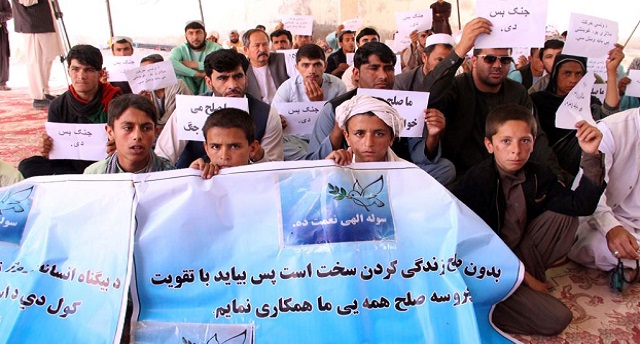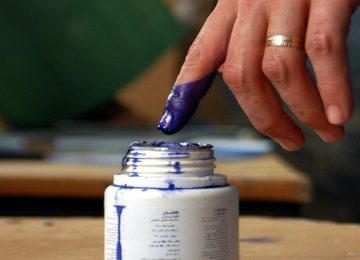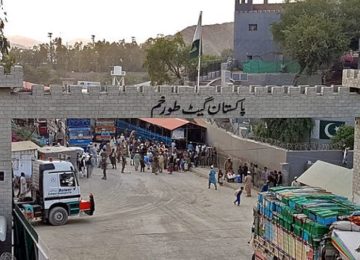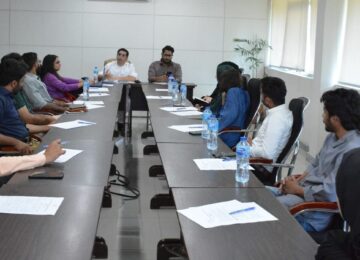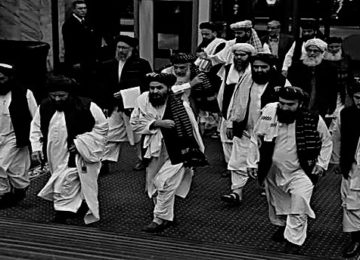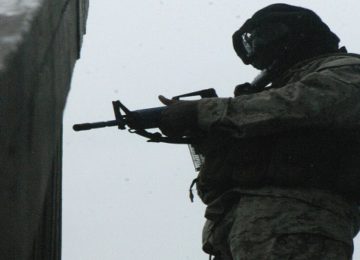Protests in Helmand calling for a ceasefire and talks between insurgents and government are about to enter their second month. The pro-peace demonstrations which began in what are often described as the Taleban’s ‘southern heartlands’, have been spreading: they can now be found in half of Afghanistan’s provinces and for now, at least, they are transcending tribal and ethnic divides. As AAN’s Ali Mohammad Sabawoon reports (with input from Thomas Ruttig), both Taleban and government appear to have been wrong-footed by the protesters, unsure how to respond.
The relatives of victims, activists and other residents from Helmand – both men and women – who began a sit-in for peace following a car bomb suicide attack in the provincial capital of Lashkargah in late March 2018 which left dozens of civilians injured or dead (see a media report here), are now taking their initiative a step further. Spontaneous reactions in other parts of Helmand, where tents were erected and other forms of protest occurred, have spread to neighbouring Kandahar, as well as to other provinces – 16 in all. Sit-ins in support of the Helmand protestors have been organised Herat, Nimruz, Farah, Zabul, Kandahar, Uruzgan, Ghazni, Paktia, Kunduz, Kunar, Nangrahar, Balkh, Parwan, Daykundi, Maidan Wardak and Jawzjan.
A tent was erected in Sheberghan, Jawzjan’s capital, for example, on 20 April, where Tolo News quoted Farzin Fahimi, a female activist there, as saying this was a message to those who choose war: join the peace process. She added that civil society would help them with their legal demands, ensuring they would be accepted. Another tent was erected in Maidan Wardak province on 19 April in support of the movement. One of the protestors, Dr Najieullah Samun, told Pajhwok News Agency that the people were fed up with war. He called on both sides of the conflict to observe a ceasefire as soon as possible in order to pave the way for peace talks.” In Charikar in Parwan province, civil society activists also erected a tent (see media report here), where Pajhwok news agency quoted Khalida, a female participating activist, as saying “This move is in support of the people of Helmand.” Muhammad Sabir Fahim, a civil activist who spoke on behalf of the protestors, called on the Afghan government, armed groups and the United Statesto end the conflict in the country. “The people are tired of war,” he said. Support meetings have also been held in two other provinces, Bamyan and Badakhshan (although only some of these have been reported in the media, see here; and here).
These place names clearly indicate that people from non-Pashtun areas have also joined the protests, potentially making this a countrywide movement for peace.
Another protest tent was also planned for the capital, Kabul. A few days ago, one of the organisers, Eqbal Khaibar (a local journalist and youth activist) and his team met the relatives of victims of attacks in Kabul, as well as other civil society members and youth activists who told him they would support the Helmand initiative. However, officials have not allowed their tents to be erected in Zarnegar Park. They argued it was too close to the high-security Serena hotel, one of the few places where foreigners on official trips can still stay (they made no mention of its use by government officials, although that might also have been on their minds). Until now, the government had not objected to tents being put up in this park, which has been a popular location for similar protests on several earlier occasions. Khaibar told AAN on 16 April that they would choose another place for the tents. Up till now, no protest tent had gone up in the Afghan capital. Khaibar further told AAN he had had meetingsin Kabul with nearly 320 civil society representatives, as well as political groups, government and media.
Khaibar told AAN that a large gathering – a ghundain Pashto – is planned for today, 23 April, in Lashkargah, in which representatives from all provinces will participate. There, they plan to reach a consensus and declare their decision to go to Musa Qala, the district centre that has served as a ‘capital’ for the Taleban since they took it over in 2015 (read AAN analysis here) to meet insurgent representatives. This was the initial plan when protests began, but it had to be postponed. Khaibar said, “We are very thirsty to go there.” According to Khaibar, the protestors see themselves as intermediaries between both sides and want to bring about talks between the Taleban and the government.
For this, the protestors want to muster additional public support. On 17 April, Khaibar said, a preparatory gathering in Lashkargah was held in order to appeal to the Taleban to allow telecommunication companies to resume their services, phone connections in Helmand have been down since 14 April, which has hindered plans for rallying supporters. However, protestors have announced that teams will go from street to street, to villages, schools and madrassas in order to inform people of the outcome of the ghunda. The Taleban, however, have claimed that closing down mobile phone services had been taken for the protestors’ security (they did not explain further).
In the past, Khaibar explained, the Taleban had been afraid that armed people would join the peace march and therefore refused to let protestors come to Musa Qala. At the same time, he said, there was support from “local Taleban; we are in contact with them every day.” But, he said, “the real problems” were with the ministries of defense and interior and the National Security Council, who, in his opinion, do not have a real plan for peace, while “the president and a limited number of people around him are determined to work for peace. “When we work on the Taleban mindset and make some progress,” he said, “the government forces carry out an attack or airstrike that negatively affects the Taleban mindset”and this, he said, throws their initiative off-track.
How the initiative began
The sit-in for peace in Lashkargah and the Helmand Peace March initiative began on 26 March 2018 when a protest tent was erected at the Ghazi Ayub Khan Stadium in Lashkargah, two days after after a suicide bomber drove his car into a crowd leaving a wrestling event at the stadium, killing over a dozen civilians and injuring 40 others. Youths tied white banners around their heads with the slogan “Jang bas dai, sola ghwaru,” (Enough war, we want peace). Protestors asked the Taleban to initiate talks with the government.
One of the victims’ relatives and one of the first to join the Helmand protest is Obaidullah, originally from Nawzad district but now living in Helmand. He told AAN that four of his nephews had been killed in the explosion at the in Ghazi Ayub stadium. “Six others of our family members were injured, two of whom are still in the hospital.” He added that he was also at the stadium but had gone to pray just three minutes before the explosion. “Our tears have not dried yet.” He said. “We want the Taleban and the government to stop killing innocent people.”
On the second day of the protest, women’s rights activists as well as those who lost their relatives in the war also joined the sit-in. The protestors declared their intent to march on Musa Qala, 87 kilometres to the north of Lashkargah, conveying their message of peace to the Taleban. They demanded that, in order to facilitate the march, both insurgents and the government must declare a ceasefire for at least two days and that the government delay their planned “Operation Nasrat” (Victory) against the insurgents.
The women would play a very specific role in this. In Afghan tribal tradition, when women perform nenawati (entering a house to demand help or seek forgiveness), the request is rarely rejected, although such traditions have been worn threadbare over the last four decades of war. Female members of the High Peace Council voiced their support for Helmand’s women on 1 April, saying in a statement, “We support the voice of Helmandi women who have lost their sons, brothers, husbands and relatives in the war.”
By then, the protestors had adopted the name ‘Helmand Peace March’ for this initiative – which is also the hashtag for their mobilisation on social media – and De Sole Wulusi Harakat (People’s Peace Movement). An organiser told AAN that their leadership council comprises nearly 20 people, but said he would not disclose all the names. Some of the organisers are known, however, as they have spoken to the media and been active on social media. Apart from Eqbal Khaibar, those who started the sit-in include Muhammad Erfan, a medical doctor, Qais Hashemi, a Helmandi singer famous for his song Sola Ghwaru (We Want Peace), Bacha Khan, another youth activist, as well as Ahmad Jan and Safiullah Sarwan. Khaibar described the group’s members as “people who have a national mindset,” ie not having any affiliations with organisations or militant groups, be they mujahedin or other. As is customary, the participating women’s backgrounds were not provided. It is very rare for women in southern Afghanistan to be allowed to be seen outside of their households, not to mention take on a political role.
The protestors indirectly responded to President Ashraf Ghani’s announcement on 28 February 2018 that his government was ready to talk with the Taleban without any preconditions, in any location (see AAN analysis here). The Taleban have not yet published an official reaction to Ghani’s offer; indeed both sides intensified their military activities in the weeks following the offer of talks.
The demonstration was inspired, in part, by the Pashtun Tahafuz (Protection) Movement, which also uses the name parlat (Pashto for ‘sit-in’) and was launched in Islamabad, the capital of Pakistan, on 1 February 2018. The protestors’ core demand was that the Pakistani security establishment stop the torture and extra-judicial killings of Pashtuns following the high-profile death of a young Pashtun shopkeeper, allegedly at the hands of police in Sindh. That protest lasted until 10 February, when Pakistani authorities promised that it would fulfill the demands within a month. The protestors announced the end of the sit-in but warned of future strikes if their demands were ignored.
The Taleban and the government’s reactions
On the first day of the sit-in, local Taleban reportedly welcomed the demonstration and its demands. Provincial authorities also showed an interest in a dialogue with the protestors and reiterated the government’s position that they were ready for peace talks without preconditions.
But the first official statement by the Taleban was less sympathetic (see here in Pashto). On 28 March they told the protestors they “should go to Shurab and Kandahar airbases of [the] American forces and ask them for peace instead coming to Musa Qala.” The statement warned that protestors should not go to Taleban areas because international forces or intelligence services might take advantage of the situation “and something might happen to you.” The statement added that the Taleban “would be compelled to react” if the march were to be instrumentalised, “and then the responsibility will fall on your shoulders.” The statement noted a widespread desire for peace in Afghanistan and claimed that the Taleban had made sacrifices for the sake of security in the country. “It’s now the duty of the whole nation including you [the protestors] to raise your voice against invaders”, the statement said.
There was also serious wavering on the government’s side. When the protestors went to the provincial government’s office in Lashkargah asking for a ceasefire so they could start their march to meet the Taleban, the government asked for time. Khaibar told AAN that the provincial government had told the activists it had submitted their proposal to the National Security Council in Kabul and would soon respond. But no response came before the deadline set by the protestors.
The response of the protestors
The Taleban’s negative message and the lack of a timely and concrete reply from the government provoked a furious response from the protestors. On 29 March, they announced the march to Musa Qala would be delayed and some of them converted their protest to a hunger strike that same day. A video spread on social media showing one of the organisers weeping and pleading for peace. Hashemi, the singer, expressed his anger at both sides (here on Facebook): “You have destroyed the lives of the people. My tears became dry.” Khaibar told AAN that the march would be delayed “until we receive a response from the government [about] whether or not they accept our proposal of ceasefire, at least to present to Taleban that we have this commitment from the government and now this is your turn.”
As the hunger strikers also refused to drink water, six of them soon had to be hospitalised. Seeing this, Sayed Gul Sarhadi, a local journalist based in Lashkargah and a participant of the sit-in, told AAN a group of religious scholars with a reputation for impartiality intervened and pleaded with the hunger strikers to stop. They also offered to mediate between the government and the strikers. The hunger strike was ended after 48 hours. But the protestors remained in their tents and their protest started to spread throughout the country. They also set out conditions for those to join: government officials could not participate; they would not eat in the tents and only drink water (but not bottled mineral water); and slogans and demands should only be about peace; no other slogans were allowed.
A local scholars’ committee consisting of 15 religious figures was formed on 1 April, headed by Sheikh Habibullah, a famous religious scholar in Helmand who was accepted by the protestors as a trustworthy personality. The scholars decided they would also take part in the sit-in and would continue the struggle until their demands for peace were accepted. At the same time, the scholars warned the protestors that preparing any future peace march on Musa Qala would require time for preparation.
On the same day the protests spread to Nawa and Gereshk, two Helmand districts that have been heavily embattled over the past months, and where demonstrators have also set up tents. On 3 April residents of Washir, a third district in the province, gathered to support the sit-in and planned to set up their own tents the following day. Washir is home to conservative Taleban who control 95 per cent of the district. Protest co-organiser Khaibar said the local Taleban had endorsed the demonstration and that their relatives were among the protestors. But “some outsiders” – referring to Taleban from other districts or provinces – were against it, so they decided against erecting a tent there, for fear that a conflict might occur – “and we stand against conflict.” Khaibar added, “We are working on Garmsir district, too.”
On 9 April Khaibar told AAN “We [also] managed to set up tents in Zabul and Kandahar and we are now in Kabul finding the families of the martyrs of Zanbaq square [the 31 May 2017 tanker truck bomb – see here] and other bomb attacks and talking with them. We would erect the tent in Kabul through them.”
How did other parts of the country react?
The protest first caused reactions in neighbouring Kandahar. On March 28, dozens of elders, including members of the provincial council and religious scholars, gathered in the provincial capital and called on the Taleban to give a positive response to the demands of the people raised in Helmand. One of the religious scholars, Mawlawi Muhammad Haq Khatib, said “now it is time the Taleban give a positive respond to the demands of the people regarding peace.” He also said that this parlat should not be limited to Helmand province but should spread countrywide. Khatib is a leading member of De Wolus Ghag (Voice of the People), a local political movement established recently. (1)
In the meantime, in Kabul, another sit-in was launched in support of the demands of the Pashtun Tahafuz Movement in Pakistan at Chaman-e Hozuri, a popular spot near the national stadium. Its participants also voiced their support for the aims of the Helmand peace sit-in. This sit-in was another example of the significant risks linked to such gatherings and demonstrations in Afghanistan, as on its ninth day, on 4 March, an explosion killed one protestor and injured fourteen others. The incident was attributed to a magnetic bomb (media report here). No insurgent group has claimed responsibility for the attack. Shortly afterwards, protestors held a press conference and told journalists that they would continue their demonstration. (2)
On 1 April, members of the Meshrano Jirga, or upper house of parliament, discussed the sit-ins in Helmand and offered their support. Initiated by a Helmandi senator, the house called on the inhabitants of other provinces of the country to support the Helmandis and raise their voices for peace. On 2 April, the Wolesi Jirga, or lower house, followed suit and unanimously declared its support for the Helmand demonstrations.
On the same day, dozens of civil society activists and youths from northern Balkh province gathered at the Hazrat Ali Shrine in Mazar-e Sharif in support of the Helmand protestors with the slogan: “Dear Helmandis! You are not alone. We are with you.” (media report here). Since then, local residents have erected a permanent tent to show their support to Helmandi protestors there, too (see here).
AAN approached several older civil society groups and political movements for their reactions. Raihana Azad, a member of the leadership council of Jombesh-e Roshanayi and MP for Uruzgan province, told AAN on 8 April, “Really, they are the voice of those who are the victims of the war. In this peace protest we hear the voices of mothers who have lost their sons, the voices of the widows who have lost their husbands and the voices of those who have lost their relatives.” Aziz Rafiee the member of Transitional Justice Coordination Group (TJCG) and director of the Afghanistan Civil Society Forum (ACSF) also told AAN that he supported the peace sit-in in Helmand and thinks that it is a response to an “urgent need of the people.” He said he had also done so in the media and hoped for “a fruitful outcome.” Ahmad Parwani, a member of Jombesh-e Taghir wa Rastakhez (Uprising for Change Movement) also welcomed the sit-in. He said their leading members were not currently in Kabul. Otherwise they would have also raised their voices in support of the Helmand sit-in. All three more or less cited the alleged lack of interest in peace on the part of the government and regional powers as reasons why an ‘all-Afghan’ peace movement had not arisen until now. Enthusiastic support also has a different chime to it.
Moving beyond Afghan divides
This is the first time – in spite of significant risks – that people in southern Afghanistan have publicly, and over a sustained period of time, raised their voices against Taleban violence and mobilised publicly, and with such energy. Even the initial unfavourable response has not made them give up; it has actually strengthened their resolve. This protest is also remarkable insofar as it is happening in an area often described as the ‘heartland of the Taleban’.
Indeed, the Taleban control more than half of Helmand’s territory while the government’s hold is limited to the administrative centres of six districts – Nawa, Marja, Nadali, Gereshk, Garmsir and Washer – as well as Lashkargah, the provincial capital. The population in the Taleban-controlled areas provides them with refuge, food and money but it is difficult to say how many do so voluntarily and how many by coercion. It is also clear that the never-ending war has inflicted significant costs to many inhabitants in Helmand province and they are getting more and more tired about this. The protest makes clear that there is dissent due to the Taleban’s violent actions among many in this Pashtun-majority province. Moreover, the Taleban’s control over large areas gives the people an address where they can their concerns and complaints to the Taleban.
The Lashkargah stadium bombing has led those who lost their loved ones to raise their voices, take to the streets, protest against the war and ask for peace, put public pressure on the Taleban. The images of Taleban attacks killing innocent civilians that have spread across social media may have contributed to undermining their prestige and raised questions about the legitimacy of their war. These reactions indicate that people are tired of the fighting and cannot endure further atrocities. As Pashto idiom says: “The power of people is the power of God.” If the civilians can bolster the Taleban, they can also undermine them.
It is unsurprising that leaders from both sides of the conflict have demonstrated so little enthusiasm for the Helmandi protestors. The government took so long to react to their request for a ceasefire, the march on Musa Qala had to be postponed; the official Taleban reaction was even more discouraging. Furthermore, neither side has shown much interest in brokering peace. Since the conclusion of the second peace conference in Kabul, neither party has decreased its military activities. On 2 April, an Afghan airstrike killed and injured at least 150 civilians in Dasht-e Archi district in Kunduz province. This kind of incident drives recruitment for the Taleban and feeds the narrative among insurgents that peace talks are just a money-making project for government officials.
Against this backdrop, the success of the organisers of the Helmand Peace March depends on their ability to keep their initiative up and mobilise more people in their province as well as countrywide. Scores of people have lost relatives in the war and a number of recent, large attacks have generated public outrage as well as protests (see AAN reporting here and here) – this is a large constituency to tap into.
The protest organisers are now systematically reaching out, and, given the number of protest tents that have gone up as well as other support activities, they have achieved much already. Remarkably, the protest has transcended the south-north divide, most notably between Pashtuns and non-Pashtuns. However, the less than enthusiastic reaction from some civil society activists in Kabul that AAN noted indicate that there still seem to be reservations and maybe even scepticism and bias towards what appear to be newcomers on the scene.
The protestors have tried to maintain their impartiality by preserving their distance from the government and by not allowing other interests to take over, hence the ban on slogans on anything other than for peace. They have not heeded, however, the Taleban’s demand that protestors go to US military bases.
It is also striking that ordinary Pashtuns on both sides of the Durand Line who are tired of the insecurity in their particular areas are protesting in large gatherings, rallying young people in mostly peaceful protests. Regardless of whether inspiration is mutual or even whether there are any direct exchanges among those mobilising, organisers on both sides claim they want to build civil movements for obtaining basic rights and have expressed commitment to the peaceful pursuit of democratic aims.
(1) Some sources from Kandahar told AAN said Khateb was close to the Karzai family and that the head of the provincial council, another Karzai ally, was present at the meeting.
(2) On 23 July 2016, the big TUTAP protest (AAN analysis here) in Kabul organised by the Enlightenment Movement (Jombesh-e Roshnayi) was attacked by suicide bombers causing a large number of casualties (UN report here).
By Special Arrangement with AAN. Original link.
Disclaimer: Views expressed on this blog are not necessarily endorsed or supported by the Center for Research and Security Studies, Islamabad.



